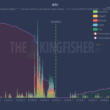The cryptocurrency market is experiencing significant price fluctuations in June 2025, with major coins like Bitcoin, Ethereum, and Solana showing notable declines amid broader market shifts and emerging geopolitical tensions. This update highlights the latest price movements, market sentiment, and underlying factors shaping the crypto landscape.
Overview of Recent Price Movements
June 2025 has seen a volatile performance across top cryptocurrencies. Bitcoin (BTC) currently trades near $104,806, reflecting a 2.48% drop. Ethereum (ETH) experienced a sharper fall of 8.51%, priced at $2,517. Alongside these giants, Solana (SOL) slumped by 9.25% to $144.61, while other notable assets such as Dogecoin (DOGE) and Cardano (ADA) also faced declines over the past 24 hours.
Stablecoins like USDC and USDT have maintained their pegs close to $1, with minimal fluctuation, reinforcing their role as safe-haven assets amidst market uncertainty. Conversely, tokens like PEPE and ARB recorded double-digit percentage drops, underscoring the heightened speculative nature of smaller altcoins.
Factors Influencing Market Trends
The current market landscape is influenced by a mix of geopolitical tensions, regulatory developments, and institutional activity. Heightened concerns around Israel-Iran relations have induced caution among investors, dampening momentum after recent rallies. Additionally, legislative progress such as the U.S. House advancing the GENIUS Act reflects ongoing regulatory interest, potentially impacting crypto-assets’ future.
Meanwhile, institutional strategies underline growing bitcoin adoption; for example, companies like Gamestop are mobilizing significant capital to acquire BTC, signaling confidence in digital assets’ long-term value. On the technological front, expansions in stablecoin markets and improvements in decentralized finance products continue advancing the ecosystem’s maturity. Notably, derivatives trading shows interesting dynamics with Ethereum’s perpetual futures volume edging past Bitcoin’s.
Key Stats & Figures
- Bitcoin Price: $104,806, down 2.48%
- Ethereum Price: $2,517, down 8.51%
- Solana Price: $144.61, down 9.25%
- Stablecoin Stability: USDC and USDT remain near $1 with fluctuations under 0.1%
- ETH Perpetual Futures Volume: $45.2 billion, surpassing BTC’s $38 billion
- Notable Altcoin Drops: PEPE -13.23%, ARB -12.15%, and others showing significant volatility
Emerging Institutional and Regulatory Developments
Institutional adoption sees an upbeat trend as firms expand Bitcoin treasuries and move into crypto debt projects. For instance, major corporate actors are raising capital to buy additional BTC, reinforcing bitcoin’s status as a digital reserve asset.
Simultaneously, regulatory frameworks are evolving globally. South Korea introduced plans to regulate stablecoins, the U.S. is scrutinizing new ETFs and staking products, and entities like Moody’s are launching credit ratings for blockchain-based assets such as Solana’s RWA structures. These developments are anticipated to add layers of legitimacy and security to crypto markets in the medium term.
Conclusion: What This Means for the Market
The crypto industry continues to navigate complex geopolitical and regulatory landscapes, directly influencing price performance and investor sentiment. While short-term volatility remains high—exemplified by steep declines across major tokens—the broader trend points toward institutional involvement and regulatory clarity, which could foster a more robust market ecosystem.
Investors should closely monitor unfolding geopolitical developments and regulatory announcements, as these are poised to shape crypto’s trajectory in the coming months. Maintaining a diversified portfolio with attention to stablecoins and high-quality altcoins may offer a balance between risk and opportunity amid ongoing market dynamics.


